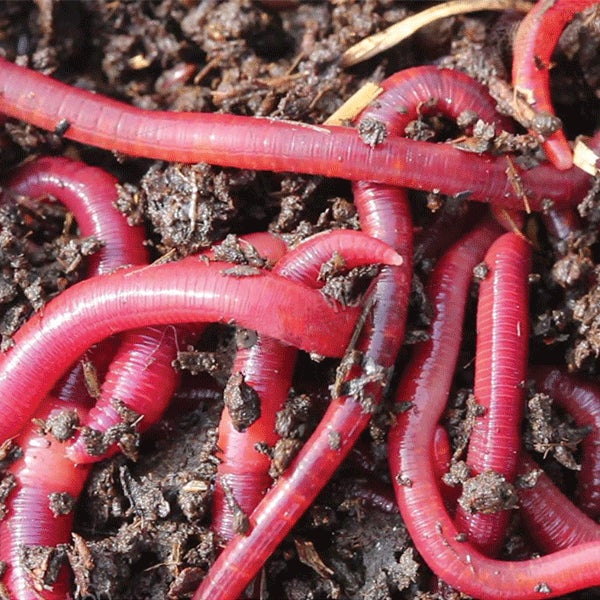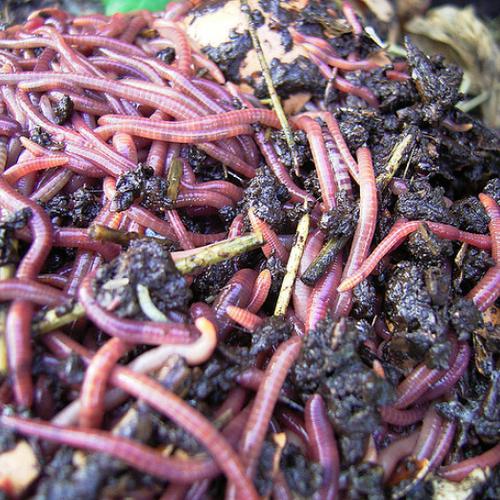The Duty of Red Wigglers in Sustainable Gardening
The assimilation of red wigglers right into sustainable gardening techniques supplies a compelling technique to boosting dirt health and decreasing organic waste. These microorganisms not just transform kitchen scraps into nutrient-dense compost with vermicomposting yet also aerate the dirt, promoting optimal problems for plant growth. As they break down facility natural materials, they actively foster a flourishing microbial ecological community necessary for lasting farming. The implications of utilizing red wigglers extend past simple composting; their function in shaping a more lasting future warrants a deeper exploration of their advantages and sensible applications.
Recognizing Red Wigglers
Red wigglers, clinically referred to as Eisenia fetida, are a varieties of earthworm renowned for their function in lasting gardening and composting practices - red wigglers. These worms prosper in breaking down raw material, making them specifically efficient in transforming kitchen area scraps and backyard waste into nutrient-rich garden compost. Unlike conventional earthworms, red wigglers have a greater tolerance for differing moisture levels and can flourish in atmospheres with abundant organic product
(red wigglers eisenia fetida)Typically, red wigglers are smaller than their earthworm counterparts, typically measuring between 3 to 4 inches in length. They have a reddish-brown pigmentation and have a fractional body structure that aids in their burrowing and feeding activities. These microorganisms are hermaphroditic, suggesting each private possesses both male and female reproductive body organs, which permits effective population development under ideal conditions.
The environment choices of red wigglers include moist, dark settings abundant in organic content, such as garden compost containers or worm farms. Their ecological role extends past composting; they are important in freshening the soil and helping with nutrient cycling, which inevitably adds to healthier yard ecological communities. red wigglers. Comprehending the biology and behavior of red wigglers is essential for those looking for to implement reliable vermicomposting in sustainable horticulture
Benefits of Vermicomposting
Vermicomposting offers numerous advantages that boost sustainable horticulture practices and add to environmental wellness. One of the key benefits is the improvement of organic waste right into nutrient-rich garden compost, which enhances dirt structure and fertility. The castings generated by red wigglers are packed with helpful microorganisms and crucial nutrients, making them an outstanding all-natural plant food.
Additionally, vermicomposting significantly decreases land fill waste. By diverting kitchen scraps and lawn waste from garbage dumps, this technique not only reduces methane exhausts-- a powerful greenhouse gas-- but likewise advertises a round economic climate, where waste is repurposed as a source.
An additional benefit is the enhancement of soil aeration and drain (red wigglers). The burrowing activity of red wigglers produces networks in the dirt, permitting air and water to penetrate more easily, thus promoting a healthier root system for plants
Additionally, vermicomposting can be done on a tiny range, making it accessible for urban gardeners and those with limited space. This method encourages environmental stewardship and understanding, as individuals become much more engaged with their waste management practices. Ultimately, vermicomposting represents a sustainable, efficient, and environmentally friendly method to gardening that benefits both plants and the planet.
Just How to Beginning Vermicomposting
Beginning your own vermicomposting system can be a gratifying endeavor that enhances your lasting horticulture methods. To begin, select an appropriate container, such as a plastic container or wood box, with great drainage and ventilation. The dimension will certainly depend on the quantity of cooking area scraps you produce; a bin of 10-14 gallons typically suffices for a house.
Next, prepare the bedding product. Shredded newspaper, cardboard, and coconut coir are excellent alternatives, supplying a comfortable environment for the red wigglers. Goal for a bed linen deepness of regarding 4-6 inches, which should be wet however not soaked.
When the bedding is developed, introduce your worms. Red wigglers (Eisenia fetida) are one of the most suitable for composting. Begin with around one pound of worms for every single 2-3 pounds of kitchen area scraps weekly.
Begin including kitchen area waste, preventing meat, dairy, and oily foods, as these can bring in parasites and develop odors. On a regular basis monitor the container's moisture degrees and temperature, guaranteeing it remains within the excellent range for worm task. With these initial steps, you'll be well on your means to creating nutrient-rich compost for your yard.
Keeping a Healthy Worm Container
A thriving worm bin needs regular care and interest to preserve an optimum environment for the red wigglers. Secret variables to monitor include wetness degrees, temperature level, and food supply. Maintaining a moisture level similar to a wrung-out sponge is critical; excessive water can result in anaerobic problems, while inadequate can dehydrate the worms.
Temperature level is additionally critical, as red wigglers flourish in a series of 55 to 77 degrees Fahrenheit. Extreme temperatures can worry the worms, possibly causing death. Positioning the container in a climate-controlled location or making use of protecting products can assist control temperature fluctuations.

Lastly, oygenation is vital. Consistently turning the bed linen and using a fork or shovel can stop compaction and advertise airflow, making sure a healthy, flourishing setting for the red wigglers. By adhering to these methods, garden enthusiasts can maintain an efficient worm container that supports sustainable horticulture initiatives.
Effect On Soil Health And Wellness
Enhancing soil health and wellness with the usage of red wigglers is a fundamental facet of lasting gardening. These worms, understood clinically as Eisenia fetida, play an essential function in boosting soil structure and fertility. By taking in raw material, red wigglers damage down complex materials into easier compounds, a procedure referred to as vermicomposting. Completion item, worm castings, is abundant in crucial nutrients, consisting of nitrogen, phosphorus, and potassium, which are vital for plant growth.

(purchase red worms)Studies have actually shown that soils improved with worm castings exhibit increased microbial task and enhanced fertility, leading to greater crop returns. By integrating red wigglers into horticulture methods, gardeners not just enrich their dirt however also add to a more lasting agricultural system, stressing the interconnectedness of soil wellness and environmental stewardship.

Verdict
Finally, red wigglers substantially add to sustainable gardening through their efficient vermicomposting methods. Their capability to transform natural waste right into nutrient-rich compost enhances soil fertility and supports a diverse microbial ecological community. Their burrowing activity improves soil aeration and water retention, benefiting plant health. By advertising waste decrease and cultivating a round economic situation, red wigglers become crucial parts in green horticulture campaigns, highlighting their crucial function in environmental sustainability.